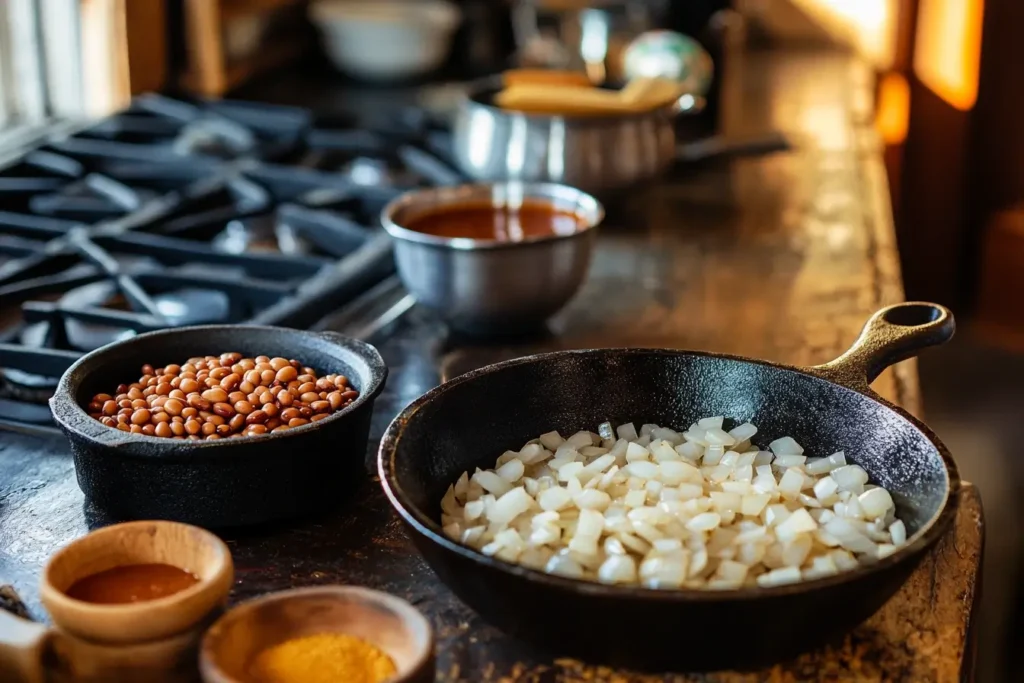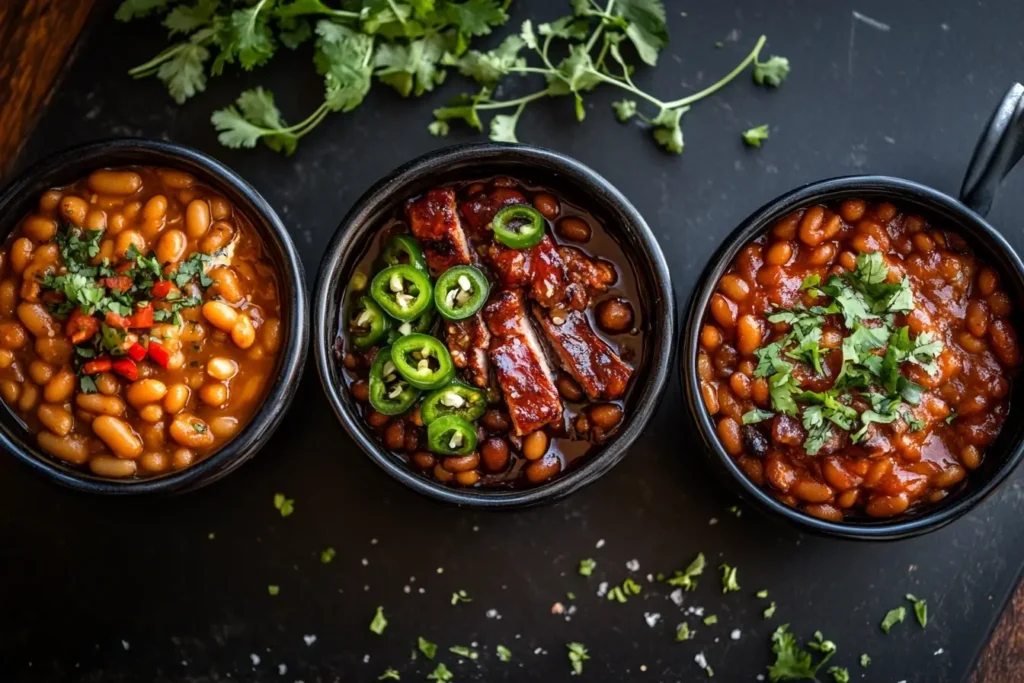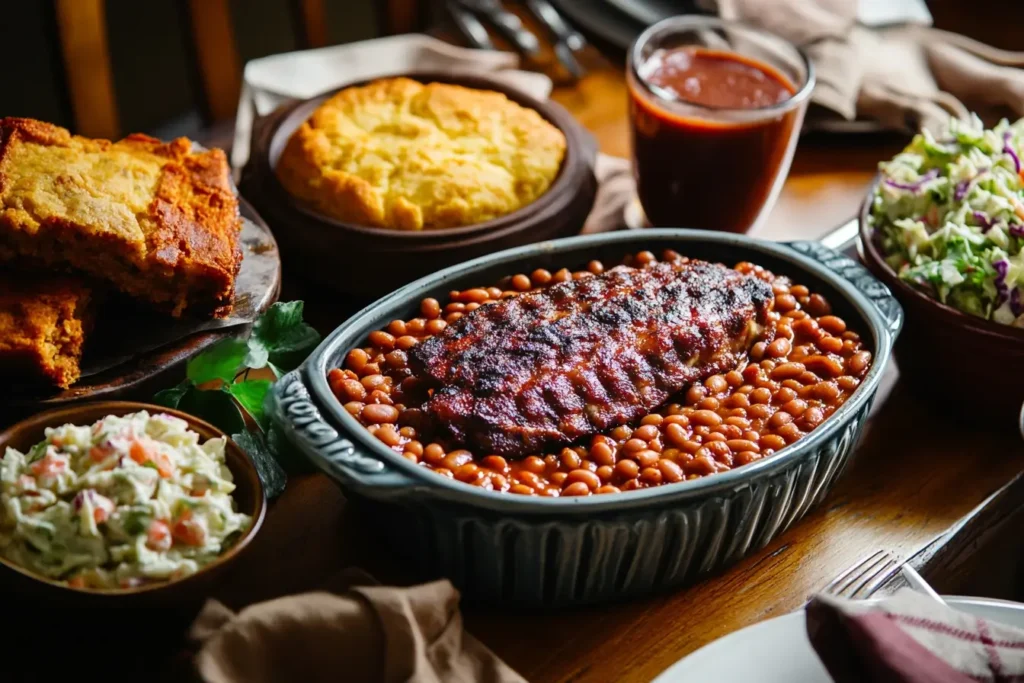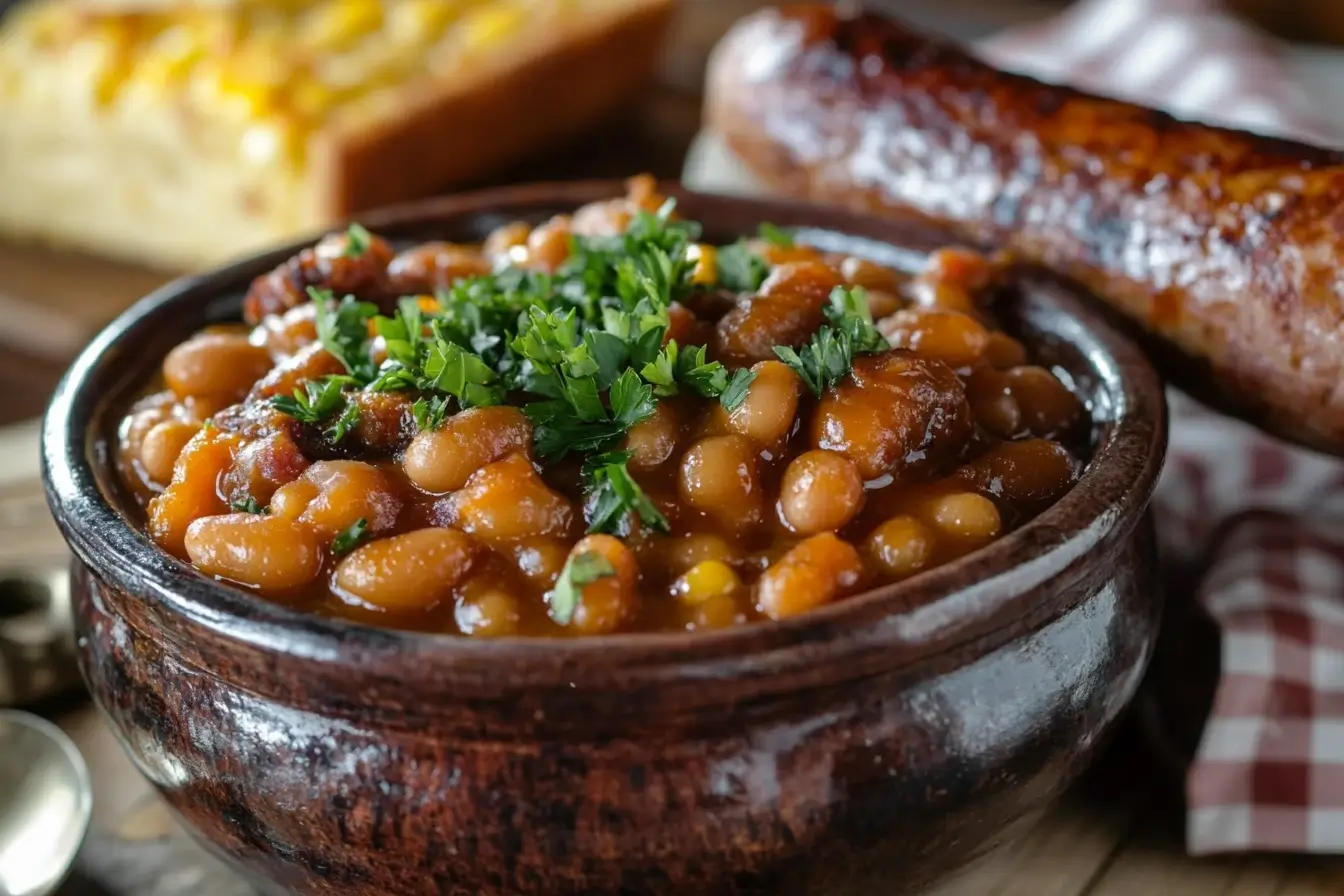Baked beans are a classic comfort food, loved in many countries around the world. This dish mixes soft beans with a sweet and tasty sauce, making it a great side or main dish. Whether served with grilled meats, paired with cornbread, or enjoyed as a filling meal on its own, baked beans are appreciated for their cozy and rich taste.
Making baked beans at home lets you change the recipe to fit your taste. You can make them sweeter, smokier, or spicier. Compared to canned options, homemade baked beans are tastier, more affordable, and free of unnecessary additives. Let’s explore the history, different styles, and tips for making this popular dish.
What Are Homemade Baked Beans?
Overview of the Dish
Baked beans are usually made by slow-cooking white beans in a rich tomato or molasses sauce. This dish started with Native American and early colonial recipes. It changed a lot when molasses and other ingredients were brought over by European settlers. Over time, it became a favorite in both American and British cooking. Each region has added its own twist, showing just how flexible and loved baked beans are.
Variations Around the World
The charm of baked beans is their ability to adapt, making them popular in many cultures. In the United States, the dish is often sweetened with molasses or brown sugar, which gives it a deep, rich flavor. In contrast, British-style baked beans focus on a tomato-based sauce and are often served with a full English breakfast. Other versions from around the world include ingredients like mustard, maple syrup, or curry spices. These unique changes show how baked beans can fit many different tastes and traditions.
Ingredients for Homemade Baked Beans
Making the best baked beans starts with choosing the right ingredients. A good mix of sweet, smoky, and savory flavors is key. Picking the right staples and extras can make all the difference.
Essential Ingredients
At the heart of baked beans are navy, pinto, or cannellini beans. These varieties are particularly valued for their tender texture and their capacity to absorb flavors deeply. The beans are then slow-cooked in a flavorful sauce made from the following ingredients:
- Molasses: This adds a deep, caramel-like sweetness, providing the signature richness of baked beans.
- Brown Sugar: Furthermore, it enhances the sweetness and brings a subtle molasses flavor.
- Ketchup: Acting as the base, ketchup contributes a tangy, tomato-forward flavor.
- Mustard: Additionally, mustard adds a slight sharpness that balances the dish’s overall sweetness.
This combination of ingredients serves as the foundation, ensuring the dish delivers a harmonious blend of bold flavors.
Optional Additions
To elevate your baked beans, consider including some of these flavorful add-ons:
- Bacon: This ingredient lends a smoky, savory richness that complements the sweetness of the sauce.
- Onions: Adding onions introduces a layer of aromatic sweetness, further enriching the dish.
- Worcestershire Sauce: This ingredient provides umami depth, which enhances the complexity of the flavors.
- Smoked Paprika: Finally, smoked paprika introduces a subtle smoky kick, making the dish even more dynamic.
Moreover, experimenting with these optional ingredients allows you to customize the recipe to suit personal preferences or dietary needs. For instance, vegetarians might opt for plant-based alternatives to bacon, while spice lovers could add chili flakes for an extra kick.
Choosing the Right Beans
One key decision when preparing baked beans is whether to use canned or dried beans:
- Canned Beans: A convenient option, as they’re pre-cooked and ready to use.
- Dried Beans: Require soaking and boiling but often result in a creamier texture and better flavor absorption.
Both options work well, but dried beans are ideal for those seeking a more traditional, homemade touch.
Step-by-Step Instructions for Making Baked Beans

Making baked beans from scratch is a straightforward process. Whether you’re a beginner or a seasoned cook, these detailed steps will help you achieve perfectly tender and flavorful beans every time.
Preparing the Beans
Using Dried Beans
- Soak the Beans: Rinse the beans thoroughly and soak them overnight in cold water. This helps to soften them and reduce cooking time.
- Cook the Beans: Drain the soaked beans and simmer them in fresh water for 1–2 hours until tender. Avoid adding salt during this stage, as it can toughen the beans.
Using Canned Beans
For a quicker alternative, simply drain and rinse canned beans. They are pre-cooked, so they can be added directly to the sauce.
Creating the Sauce
The sauce is the heart of baked beans, delivering a perfect blend of sweet, tangy, and smoky flavors.
- Combine Ingredients: In a mixing bowl, whisk together molasses, brown sugar, ketchup, mustard, and Worcestershire sauce. Adjust the sweetness or tanginess to your taste.
- Sauté Aromatics: In a pan, cook diced bacon or onions until golden and fragrant.
- Simmer the Sauce: Add the sauce mixture to the pan and let it simmer for 10–15 minutes to meld the flavors.
Baking the Beans
- Assemble the Dish: Combine the prepared beans with the sauce in a baking dish, Dutch oven, or slow cooker.
- Bake or Slow Cook:
- Oven: Bake at 325°F (160°C) for 2–3 hours, stirring occasionally to prevent sticking.
- Slow Cooker: Cook on low for 6–8 hours for a hands-off approach.
- Check for Consistency: Ensure the sauce thickens to your desired texture. If it’s too runny, let it bake uncovered for the last 30 minutes.
Equipment You’ll Need
To make homemade baked beans successfully, having the right equipment is essential. While most tools are likely already in your kitchen, using specific items can make the process smoother and the results more consistent.
Essential Tools
- Baking Dish
A sturdy baking dish is crucial for oven-baked beans. Opt for a dish with high sides to prevent spillage and ensure even cooking. Ceramic or glass baking dishes are excellent choices, as they distribute heat evenly. - Dutch Oven
This versatile cookware is perfect for stovetop-to-oven cooking. A Dutch oven retains heat well, making it ideal for slow-cooking beans to perfection. - Slow Cooker
For a more hands-off approach, a slow cooker is indispensable. It allows beans to simmer gently over several hours, resulting in tender, flavorful beans with minimal effort.
Optional Tools
- Cast Iron Skillet
A cast iron skillet is excellent for sautéing aromatics like bacon or onions. Its superior heat retention ensures even browning, adding depth to your dish. - Immersion Blender
If you prefer a smoother sauce, an immersion blender can be used to partially purée the sauce before combining it with the beans. - Measuring Cups and Spoons
Accurate measurements are vital for balancing flavors in the sauce. Use a set of measuring tools to ensure consistent results.
Tips for Perfect Baked Beans
Achieving the perfect batch of baked beans requires more than just following a recipe. Here are some expert tips to help you master this dish and avoid common pitfalls.
Achieving the Ideal Texture
- Tender Beans
- For dried beans, ensure they are soaked and cooked until tender but not mushy before baking. Overcooking can lead to a mushy consistency.
- If using canned beans, rinse them thoroughly to remove excess salt and achieve a cleaner flavor.
- Thick Sauce
- Allow the sauce to simmer or bake long enough to thicken. The ideal sauce should coat the beans without being watery. Baking uncovered during the final stages helps concentrate flavors and achieve the desired texture.
Balancing Flavors
- Sweetness vs. Tanginess
- Adjust the ratio of molasses, brown sugar, and ketchup to balance sweetness and tanginess. Taste and tweak the sauce before adding it to the beans.
- Adding Smokiness
- Incorporate smoked paprika, bacon, or a splash of liquid smoke for a rich, smoky profile. This is especially important for those seeking a BBQ-style flavor.
- Salt and Seasoning
- Add salt sparingly at first, especially when using salty ingredients like bacon or Worcestershire sauce. Adjust seasoning toward the end of cooking for the best results.
Variations of Baked Beans

To increase the use of transition words and improve sentence flow, I’ve revised the sections. These changes incorporate transitions such as furthermore, moreover, additionally, therefore, in contrast, and on the other hand to enhance readability and logical progression.
Vegetarian Baked Beans
- Plant-Based Substitutes
Instead of bacon, you can replace it with smoked tofu, tempeh, or even coconut bacon. These alternatives not only add a smoky flavor but also make the dish entirely plant-based. - Flavor Enhancers
Moreover, adding soy sauce, miso paste, or nutritional yeast can elevate the umami taste, creating a satisfying depth that complements the beans. - Vegan-Friendly Sweeteners
To keep the dish vegan, use maple syrup or agave nectar instead of honey. These sweeteners work wonderfully while maintaining the desired sweetness.
Spicy Baked Beans
- Chili Peppers
To add heat, include diced jalapeños, serrano peppers, or even a pinch of cayenne. Each option offers varying levels of spiciness, so you can adjust based on preference. - Hot Sauce
Additionally, a few dashes of your favorite hot sauce can instantly bring bold heat to the dish. - Smoky Heat
Furthermore, combining chili heat with smokiness, such as by using chipotle peppers in adobo sauce, creates a flavor-packed variation that’s perfect for spice lovers.
Serving Suggestions for Baked Beans

Baked beans are not only easy to prepare but also incredibly versatile when it comes to serving options. Whether you’re hosting a barbecue or preparing a quick weekday meal, there’s a perfect pairing for every occasion.
Side Dish Ideas
- Cornbread
The sweet and crumbly texture of cornbread, when served warm, complements the rich and saucy baked beans beautifully. It’s an ideal choice for hearty, homestyle meals. - Coleslaw
In contrast, coleslaw provides a refreshing tang and crunch that balances the dish’s richness, making it a great addition to barbecues or picnics. - Grilled Meats
Moreover, baked beans pair wonderfully with grilled staples like burgers, ribs, or chicken. This combination is a favorite at backyard gatherings.
Main Dish Options
- Casserole Base
By layering baked beans with meats, vegetables, and cheese, you can create a hearty casserole. This one-dish meal is perfect for family dinners or potlucks. - Sausage and Beans
Furthermore, pairing baked beans with grilled or smoked sausages makes for a classic, filling main dish that’s always satisfying. - Beans on Toast
For a quick and comforting option, serve baked beans on buttered toast. This popular British-style meal is simple but incredibly flavorful.
Storing and Reheating Leftovers
Homemade baked beans are an excellent make-ahead option, as they often taste even better the next day. Proper storage and reheating methods ensure their flavors and textures remain intact.
Proper Storage Techniques
- Refrigeration
First, allow the baked beans to cool completely. Then, transfer them to an airtight container and refrigerate. They’ll remain fresh for 3–4 days. - Freezing
For longer storage, freeze the beans in freezer-safe containers or resealable bags. Be sure to leave space at the top for expansion during freezing. Properly stored, they can last up to 3 months.
Best Reheating Methods
Oven
To reheat in the oven, first preheat it to 350°F (175°C). Next, transfer the beans to an oven-safe dish, cover it with foil, and bake for 20–30 minutes. Be sure to stir occasionally to ensure even heating and prevent the beans from drying out.
Microwave
If you’re short on time, the microwave offers a quick solution. Simply place the beans in a microwave-safe bowl, cover them with a damp paper towel, and heat in 30-second increments. In addition, make sure to stir between intervals for even warming. This method is particularly convenient for single servings.
Stovetop
Alternatively, you can reheat the beans on the stovetop over medium heat. Stir frequently to prevent sticking, and if the sauce appears too thick, add a splash of water. This method works especially well for larger portions, as it allows for better control over the consistency.
Nutritional Information and Health Benefits
Baked beans are not only delicious but also highly nutritious, making them a valuable addition to any meal. They are packed with protein, fiber, and essential nutrients, which contribute to overall health and wellness. Furthermore, their adaptability makes it easy to adjust recipes to suit specific dietary preferences or restrictions.
Nutritional Breakdown
The nutritional content of baked beans depends on the recipe and serving size. However, a typical 1-cup serving of homemade baked beans generally includes the following:
- Calories: Approximately 250–300
- Protein: 12–15 grams
- Fiber: 6–10 grams
- Carbohydrates: 40–45 grams
- Sugars: 12–15 grams (primarily from molasses and brown sugar)
- Fat: 1–5 grams (with higher values if bacon is included)
These values highlight baked beans as a nutrient-rich food that provides both energy and essential micronutrients. As a result, they make an excellent choice for those seeking a balanced meal option.
Health Benefits
- Rich in Fiber
The high fiber content of baked beans offers several health benefits. For instance, it supports digestive health, helps regulate blood sugar levels, and promotes a feeling of fullness. Therefore, including baked beans in your diet may aid in weight management and improve overall gut health. - Protein-Packed
Additionally, baked beans are an excellent source of plant-based protein. This makes them an ideal choice for vegetarians or those looking to reduce their meat consumption while still meeting their protein needs. - Loaded with Micronutrients
Moreover, baked beans are rich in essential vitamins and minerals such as iron, magnesium, potassium, and B vitamins. These nutrients play vital roles in energy production, muscle function, and overall well-being.
Adjusting for Special Diets
Baked beans are incredibly versatile, allowing for easy adjustments to fit various dietary requirements:
- Low-Sugar Option
To reduce sugar, substitute molasses and brown sugar with natural sweeteners like stevia. Alternatively, opt for sugar-free ketchup to maintain the dish’s flavor without the added sugar content. - Gluten-Free Version
Ensure the dish is gluten-free by using certified gluten-free ketchup and Worcestershire sauce. This adjustment is particularly important for those with gluten sensitivities or celiac disease. - Vegan Adaptations
For a vegan version, skip bacon and Worcestershire sauce, or use plant-based alternatives like coconut bacon and vegan Worcestershire sauce. These substitutions make the dish completely plant-based while retaining its rich and smoky flavor.
Frequently Asked Questions (FAQs)
Here are answers to some commonly asked questions about baked beans to help you perfect your recipe and enhance your cooking experience. By following these tips and tricks, you’ll not only ensure your baked beans turn out delicious every time but also gain confidence in customizing them. Furthermore, these insights allow you to adjust the recipe to meet your specific preferences or dietary needs. In addition, they offer practical guidance for avoiding common mistakes, making the cooking process even easier. As a result, your baked beans will taste amazing, look appealing, and achieve the perfect texture.
What can I add to my baked beans?
To elevate the flavor of baked beans, several ingredients can be added. These additions allow you to customize the dish based on your preferences:
- Smoky elements: Adding bacon, smoked paprika, or liquid smoke infuses the beans with a rich, smoky flavor. For example, a small amount of smoked paprika can make a significant difference in taste.
- Spices: In addition to smoky flavors, spices like chili flakes, cumin, or chipotle can bring a bold, spicy kick to your beans.
- Sweeteners: To balance the spiciness, include maple syrup or honey. These natural sweeteners not only enhance the sweetness but also add a subtle depth to the sauce.
- Vegetarian alternatives: For a plant-based twist, consider using smoked tofu, tempeh, or coconut bacon. These options mimic the smokiness of traditional ingredients without using meat.
By combining these elements thoughtfully, you can create a personalized dish that suits any occasion.
What are the ingredients of baked beans?
The essential ingredients for baked beans are simple yet versatile. At their core, they include:
- Beans: Common choices are navy, pinto, or cannellini beans, which are known for their tender texture and ability to absorb flavors.
- Sweeteners: Molasses and brown sugar provide the characteristic sweetness of baked beans, creating a balance of flavors.
- Tangy elements: Ketchup and mustard contribute a tangy, savory edge that complements the sweetness.
In addition to these basics, you can include optional ingredients such as:
- Bacon and onions: These add a smoky and aromatic depth.
- Worcestershire sauce or smoked paprika: Both offer bold flavors that enhance the overall complexity of the dish.
With these ingredients, you can achieve the classic baked bean flavor or experiment with variations to suit your preferences.
How do they make baked beans?
Making baked beans involves a straightforward process that brings out the best in simple ingredients. Here’s an overview:
- Preparing the Beans:
- For dried beans, start by soaking and cooking them until tender. This step ensures they achieve the perfect texture.
- Alternatively, canned beans can be used for convenience, as they are already pre-cooked.
- Creating the Sauce:
- Mix together sweeteners, tangy condiments like ketchup and mustard, and your preferred seasonings. As a result, the sauce becomes rich and flavorful.
- Baking or Slow Cooking:
- Combine the beans with the prepared sauce. Then, bake them in the oven or cook them in a slow cooker until the flavors meld beautifully.
This process ensures the beans turn out tender and infused with the sweet, tangy, and smoky notes that make them so irresistible.
What’s the best way to cook canned beans?
Canned beans are a quick and easy option for preparing baked beans. Since they are already pre-cooked, they save time without compromising on flavor.
- Rinse and Drain: Begin by rinsing and draining the beans. This removes excess salt and helps improve their overall taste.
- Simmer in Sauce: Add the beans directly to your sauce. Let them simmer for 15–20 minutes, allowing the flavors to infuse.
- Baking for Richness: For baked beans, transfer the beans to a baking dish and bake them with the sauce for 30–40 minutes. This additional step deepens the flavor and thickens the sauce.
By using these methods, you can enjoy flavorful baked beans with minimal effort.
Conclusion
Homemade baked beans are a true testament to the beauty of comfort food. They combine rich flavors, hearty textures, and a sense of nostalgia in every bite. Whether you’re making them for a casual family meal, a barbecue, or as part of a festive feast, baked beans offer versatility, affordability, and an opportunity for customization.
Why Homemade Baked Beans Are Worth It
Making baked beans at home gives you full control over the ingredients and flavors. You can adjust the sweetness, add smoky or spicy touches, and make the dish just the way you like it. Homemade baked beans taste much better than canned ones and have a higher quality. Plus, cooking them yourself is often cheaper and healthier, since it avoids unwanted additives and too much salt.
Encouragement to Try the Recipe
Don’t let the process intimidate you. In fact, with simple ingredients and straightforward steps, anyone can create a delicious batch of baked beans. Whether you’re catering to specific dietary needs or experimenting with unique flavor combinations, this dish offers endless possibilities. Moreover, it’s a versatile recipe that can be adapted to suit any occasion. So, why not give it a try? You might just discover your new favorite comfort food.
Explore More Delicious Recipes
Craving more hearty comfort foods? These recipes are perfect companions for your homemade baked beans:
- Classic Southern Cornbread Recipe – A timeless side dish that pairs perfectly with baked beans.
- Savory Deer Roast Recipe – A flavorful main course to complement your comfort food table.
- Ultimate Smoked Queso Recipe – A cheesy and smoky dip to round out your meal.

